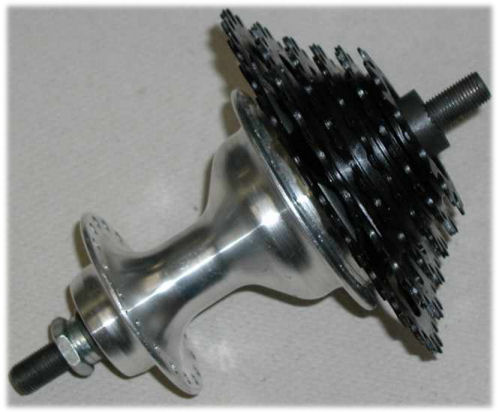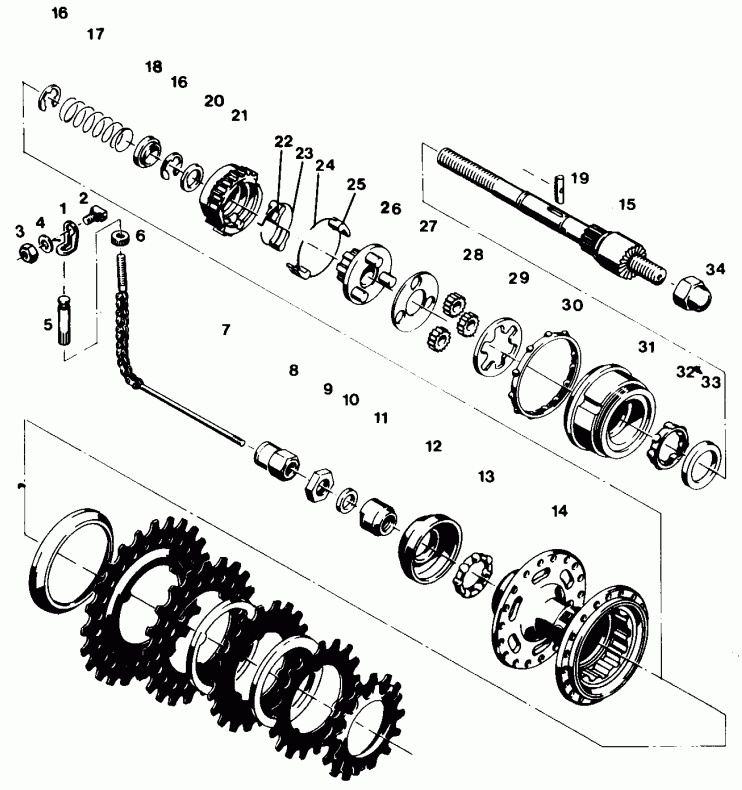
|


Image courtesy of Karstilo.net
There are also articles on this site more generally about internal-gear hubs
and about Sachs/SRAM internal-gear hubs
Sheldon Brown's Internal-Gear Calculator
![]()
The Sachs Orbit is a hybrid gearing system -- a two-speed internal-gear hub (direct-drive and 0.738 decrease ratio) with 5, 6 or 7 proprietary sprockets. The Orbit was introduced around 1990, preceding the 3 x 7 and DualDrive three-speed hubs which use Shimano-compatible cassettes. The Orbit is no longer manufactured, but we get questions about it from time to time, usually from people who would like to rebuild one.
The Orbit is easy to rebuild as internal-gear hubs go, but it was never very common, and it has been out of production for many years. To get most replacement parts, you will have to cannibalize another Orbit hub. Orbit hubs still turn up from time to time on eBay, and as of October, 2011, there was still a shop in the U.K. selling the Orbit from new old stock -- run a Web search for up-to-date information.
When rebuilding, you could use some generic and compatible parts. Axle threading is M 10x1, not the same as for other Sachs hubs, but this is a fairly common size. The leift-side nut is flared to accommodate the shifter chain. Flared nuts may no longer be available; you could modify a nut. The two outer bearing retainers could be replaced with loose balls, and new bearing balls popped into place in the bearing retainer between the driver and hub shell. The right cone is integrated with the axle, so the only options if the cone is pitted are to regrind the cone or cannibalize another Orbit.
Sprockets appear to use the same splined and threaded attachment as on old Normandy freewheels (the kind with three-spline larger sprockets and large, splined hole for the freewheel remover), except that the innermost splined sprocket of the Orbit is dished. Some early Shimano freewheels use the same spline pattern. Sprockets which have developed hooked teeth can be reground-- see description here. The Orbit's splined sprockets (except the dished one) can be flipped over to engage on the other side of the teeth.
The Orbit was available optionally with a drum brake. The brake assembly of my sample drum-brake Orbit is marked "ATB Special" and is compatible with the drum brake on a Sachs Super 7 or SRAM Spectro S7 -- and probably other Sachs/SRAM hubs. The reaction arm is smaller and shorter, but that won't usually be a problem.
The Orbit was sold grease-lubricated. Though its internal parts are rather well-protected against contamination, it will endure longest if relubricated with both grease and oil as described here. Oil may be added at the left end of the axle after unscrewing the pullchain. Do not over-oil the drum-brake version.
Karsten Stielow's Web site in Germany offers a page [now archived] with additional photos and an exploded drawing which is a good guide for rebuilding of an Orbit hub. (Note though that there are two circlips, and they are different!) The exploded drawing is also copied below.
An Orbit rebuild will have a limited lifetime, because of the increasing difficulty of finding replacement parts. Rebuilding probably only makes sense to prolong the life of a wheel, or to restore a bicycle as a historical item.
![]()
![]()
The Orbit was sold with a proprietary shifter, but because there are only two shifter positions, almost any friction shifter will shift the hub. The pullchain attachment to the cable is the same as with other Sachs hubs.
Indexed shifting of the sprocket cluster is possible, though it will not be as smooth as with modern ramped sprockets. The sprocket spacing of the 5- and 6-speed versions is 5.5 mm, making the cluster compatible with Shimano derailers and 6-speed shifters. The 7-speed version has narrower spacing, like a Shimano 7-speed cluster.
 |
Image from Sachs manual, courtesy of Karstilo.net
Thanks to Karol Woźniak for a correction about axle threading.
![]()
![]()
Last Updated: by John Allen